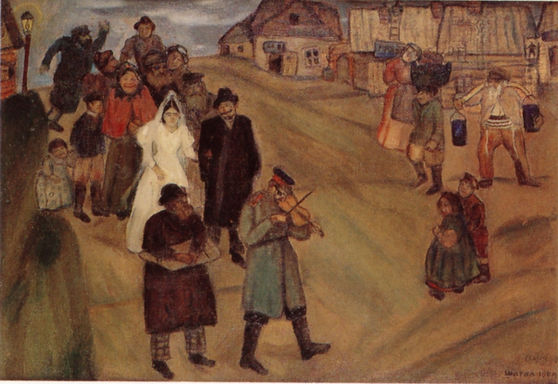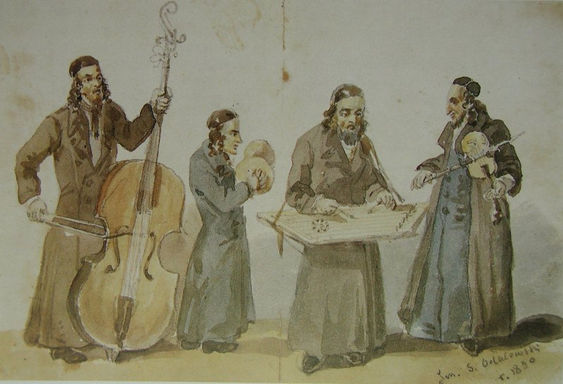
Israel Ministry of Foreign Affairs

The flower of Yiddish culture, Klezmer music
Was Chagall's Klezmer musician playing "lively dance music"? -It was a lineage of music of prayer to God, derived from the recitation of the precentor Hazan. What is the unique musical heritage of Ashkenazi Jews?
-Chitoshi HInoue (Klezmer player / Art historian)
"In the Yiddish-speaking world of Central and Eastern Europe, where 10 million Ashkenazi Jews of German descent once lived, a community called Shtetl flourished with a variety of musical cultures. At weddings, an important religious ritual, musicians called klezmer added flowers to various scenes of the ceremony. These musicians often appear in the wedding scenes drawn by Chagall. In "The Russian Wedding" (1909), a klezmer leads the bridal party on their way to the ceremony. In "The Play" (1920), the bride, groom, and attendees are all holding their eyes while the man in the center of the scene, called Badkhn, presides over the ceremony. There is no musician, but here Badkhn has a ritual to make the bride cry as she realizes her separation from her girlhood and the hardships of married life, and the emotional music of Kale Vaveinen is played. In addition, klezmer continued to play in various genres of music at each wedding scene.
Much of their repertoire is borrowed from other folk music in discrete areas, but its expression comes from the singing style of the precentor Hazan. Hazan's recitation is a prayer to God. The method of expressing emotional excitement with ornamental sounds such as vibrato and sobbing is peculiar to Jews. Klezmer also applied this method to instrumental performances, filling the solemn religious ceremony of a wedding with a sacred sound that is distinctly different from secular song and Kabuki music."
Klezmer Music at the Mercy of History
"Klezmer (ˈklez-mər)", by the way, is the English pronunciation of the Yiddish word klezmer. In the past, the elders were the center of the community in the shtetl, but with the mass migration of Ashkenazim to the United States in the 20th century and the rapid Americanization of the country, the youth became the center of the culture. Along with that, the repertoire of dance songs such as fast-paced Bulgars preferred by young people increased, and the sacred sound receded. In the 1970s, the repertoire was in danger of being overtaken by other popular music trends, but it was revived by second-generation immigrant musicians. Now, it has been revived in Central and Eastern Europe, the former home of klezmer, where Jewish culture disappeared due to the Holocaust.
In Israel, Hebrew culture was more important than Yiddish culture, so the inheritance of klezmer was discontinued, but in recent years its value has been reevaluated. Israel's original klezmer, known as the melon style, has little in common with that of the Shtetl in terms of repertoire, but the expression style derived from Hazan's singing method is inherited almost unchangeand, and in this respect the unique Jewish musicality has been maintained."

©Shendl Copitman
Chitoshi Hinoue
Klezmer player and art historian. Participated in the world's largest klezmer workshop Yiddish Summer Weimar every year since 2005, and has studied klezmer music under the presiding and Klezmer player Dr. Alan Bern. He has been working to learn and promote klezmer music while mastering the interpretation of Chagall's works. In September 2016, he established a non-profit organization, Yiddish Culture Promotion Association. He is the author of "Oh, Who Would Have Understood Chagall? (co-authored with Tsukasa Kunifuji and others, Osaka University Press, 2011).
Concert Information:
On February 21, 2021, "Eastern European Jewish Music and Klezmer Concert: Chagall's Beloved Melodies of His Homeland" will be held at Theater Kai in Ryogoku. For more information, please call Theatre Kai at 03-5624-1181.










